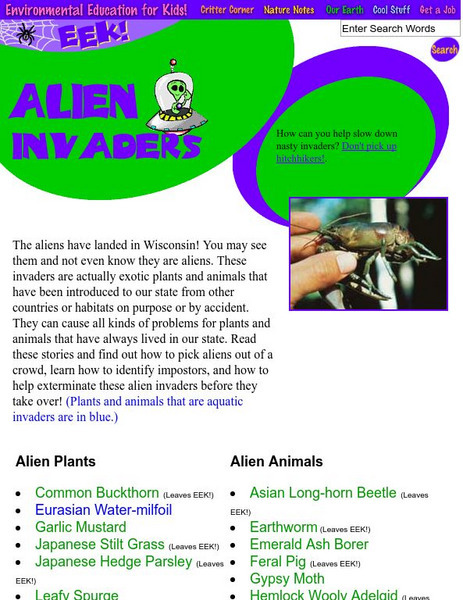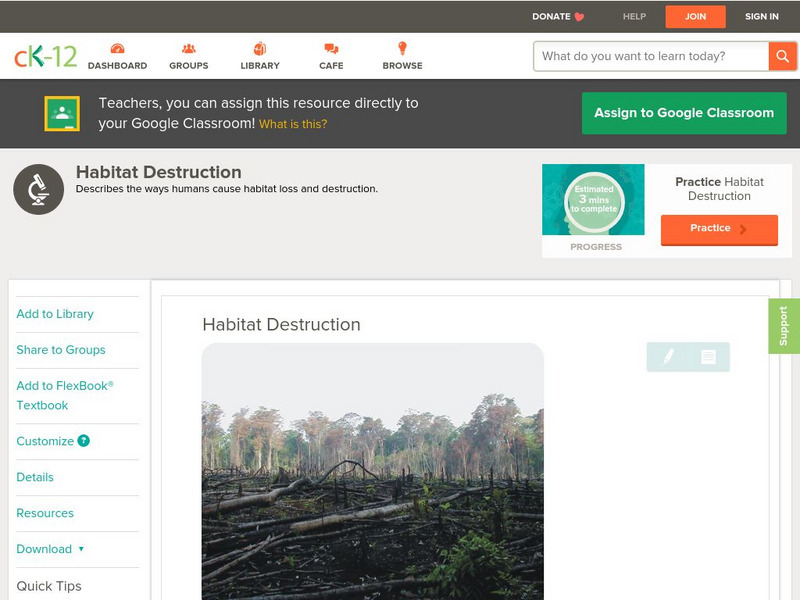Hi, what do you want to do?
E-learning for Kids
E Learning for Kids: Science: Pacific Ocean: What Can We Find on a Beach?
Josephine lives on the Marshall Islands. Follow her to the beach and find out what kinds of plants and animals live there.
PBS
Pbs Kids: Plum Landing: Jungle Jeopardy
Try keeping a whole jungle ecosystem alive by making sure each animal has enough food to survive over a period of 12 days. This game allows players to see how the different species of plants and animals in a rainforest depend on one...
American Museum of Natural History
American Museum of Natural History: Habitat O Logy Card
Flip this interactive OLogy card to find fast facts, questions and answers, and other bite-size pieces of information about the meaning of habitat, as a scientific concept, and learn why habitat is so important to plants and animals.
ClassFlow
Class Flow: Interdependence and Adaptation
[Free Registration/Login Required] In this lesson, children extend their knowledge of the way in which plants and animals in different habitats depend upon each other and are suited to their environment.
NOAA
Noaa: Year of the Ocean, Kids and Teachers Corner
Great resources on a variety of ocean and environmental concerns, endangered plants and animals, climate and habitats, frequently asked questions and fact sheets.
Other
Missouri Conservationist Online: Missouri Cave Life
Excellent article describing a trip inside a cave. The article discusses the cave habitat and changes that occur as you go deeper into the cave. Includes interesting photographs.
Buck Institute
Buck Institute for Education: Pblu: Schoolyard Habitat Project
An example of a project-based learning opportunity that engages students in learning what a healthy habitat is by working within the school's campus to increase opportunity for animals to find food and shelter, maintaining plants, and...
Utah Education Network
Uen: Trb 4:5 Investigation 1 Wetlands, Forests & Deserts
Learn about surface terrain and how plants and animals are affected by the temperatures and precipitation.
TeachEngineering
Teach Engineering: Got Energy? Spinning a Food Web
Students learn about energy flow in food webs, including the roles of the sun, producers, consumers and decomposers in the energy cycle. They model a food web and create diagrams of food webs using their own drawings and/or images from...
Environmental Education for Kids
Eek!: Alien Invaders
The aliens have landed in Wisconsin! You may see them and not even know they are aliens. These invaders are actually exotic plants and animals that have been introduced to our state from other countries or habitats on purpose or by...
Alabama Learning Exchange
Alex: Our Trip Around the Biomes
During this lesson, students travel to the biomes by way of the Internet. They learn the characteristics of biomes, including animals, plants, temperatures, etc. Students then use this information to create a slideshow presentation to...
Other
Ttu: Alpine Tundra
Information on the land uses, plants, wildlife, habitats and soil. There are literature citings at the bottom of the page.
Science Struck
Science Struck: Arabian Desert Facts
Presents interesting information about the Arabian Desert, including its physical geography, climate, plants and animals, their adaptations to the environment, natural resources, and threats to its habitats.
CK-12 Foundation
Ck 12: Life Science: Terrestrial Biomes
[Free Registration/Login may be required to access all resource tools.] A terrestrial biome is an area of land with a similar climate that includes similar communities of plants and animals. Different terrestrial biomes are usually...
Houghton Mifflin Harcourt
Harcourt: School Publishers: Exploring Ecosystems
Compare and contrast three very different ecosystems - the Sonoran Desert in Arizona, the Florida Everglades, and the Arctic Coastal Plain in Alaska. Learn what makes each of them unique, and about the adaptations plants and animals had...
Science Education Resource Center at Carleton College
Serc: Discovering Nature in Our Neighborhood: Investigating Natural Communities
Students examine the natural surroundings around the school and identify micro-communities of plants, insects, and other animals through walks and nature journaling.
abcteach
Abcteach: Ponds
[Free Registration/Login Required] The abcteach directory contains sample pages from their pond unit for non-members. Handouts are in PDF format.
ClassFlow
Class Flow: Understanding Ecosystems: Climate Part 2 of 4
[Free Registration/Login Required] This flipchart will help students understand how climate affects our ecosystems. Links are provided to further their knowledge of the types of plants and animals that live in different climate zones.
ClassFlow
Class Flow: Ecosystems
[Free Registration/Login Required] This flipchart explores the different ecosystems of the world, enhanced by embedded videos showing both the landscape and the plants and animals that can be found there.
ClassFlow
Class Flow: Energy in the Ecosystem
[Free Registration/Login Required] This flipchart focuses on how plants and animals get energy and different habitats.
Other
The Rspb: A to Z of a Wildlife Garden
Learn the steps to making a good wildlife garden that attracts all types of wildlife.
California Academy of Sciences
California Academy of Sciences: Mountains
Look at pictures of some well known mountain ranges and read about the habitats, climate, plants and animals that are found on them. There is a link for additional information about the cold aeolian zone.
CK-12 Foundation
Ck 12: Life Science: Habitat Destruction
[Free Registration/Login may be required to access all resource tools.] From a human point of view, a habitat is where you live, go to school, and go to have fun. Your habitat can be altered, and you can easily adapt. Most people live in...























